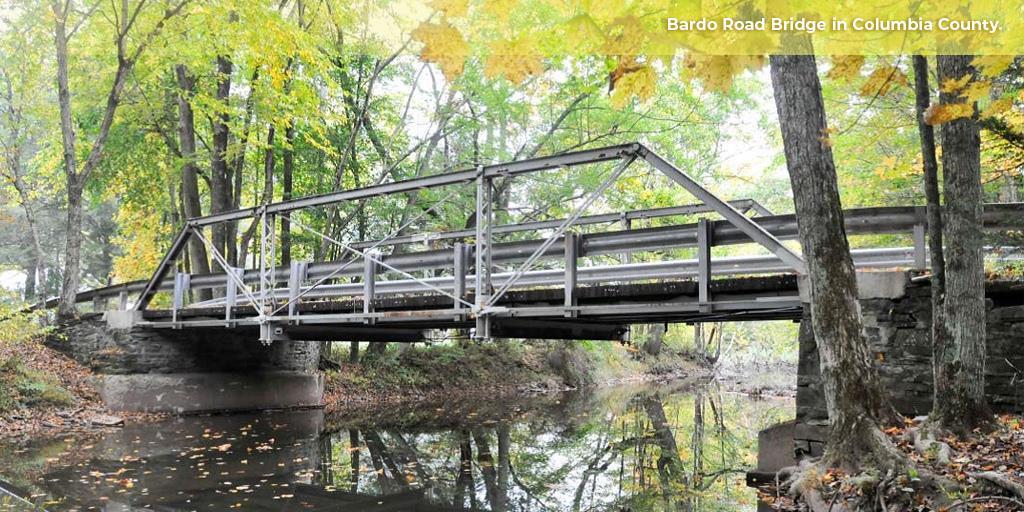
In late 2019, PennDOT's Cultural Resources Management (CRM) Program website underwent a complete transformation, bringing its design and content in line with other Commonwealth sites. One of the most noticeable changes is to the bridge marketing page, where the public finds information about historic metal trusses available for purchase. The bridges no longer meet vehicular traffic needs but remain valued reminders of Pennsylvania's innovative iron and steel industries. Rather than relegating them to the scrap yard, PennDOT seeks adaptive reuses for these National Register-eligible resources. Forty-three bridges, ranging from the 1876 Cedar Street Bridge in Franklin County to the 1915 Walp Road Bridge in Luzerne County, are featured on the marketing page. The effort aligns with the larger goals of the CRM Program to rehabilitate significant metal trusses in situ that can be brought up to current traffic standards and to identify new uses for those that cannot. PennDOT is working hard to try and save a small part of the Commonwealth's history.
The Mott Street Bridge Rehabilitation Project in Milford Borough and Dingman Township, Pike County is a recent successful example of adaptive reuse. The county-owned 1903 steel pin-connected Pratt thru truss was closed to vehicular traffic in 1988 and to pedestrians in 2011. Transportation Alternatives Program funds were used to rehabilitate the structure in place. PennDOT consulted with the Pennsylvania State Historic Preservation Office, the National Park Service, Milford Borough, Dingman Township, and local property owners to ensure work would not adversely affect what makes the bridge eligible for the National Register of Historic Places. In 2020, the bridge reopened to provide pedestrian connectivity between historic downtown Milford and the Delaware Water Gap National Recreation Area.
ABOUT THIS BLOG
Did you know PennDOT is directly responsible for nearly 40,000 miles of highway and roughly 25,000 bridges? We oversee programs and policies affecting highways, urban and rural public transportation, airports, railroads, ports and waterways, in addition to administering the state's more than 11 million vehicle registrations and 8.8 million driver's licenses.
So, how do we do what we do? And how can we help you travel in Pennsylvania — whether it be for business or leisure — in safe and enjoyable manner? Read PennDOT Way to learn more about the department, what we do, and how and why we do it.
TAGS
50-Year Anniversary, 511PA, Aggressive Driving, Airports, Autonomous Vehicles, Bicycles, Bridges, Child Safety, Community Relations, Construction, COVID-19, Distracted Driving, District 1, District 10, District 11, District 12, District 2, District 3, District 4, District 5, District 6, District 8, District 9, DOTcom, Driver and Vehicle Services, Emergency Responders, Employment, Equity, FAQ Friday, Human Trafficking, Impaired Driving, Innovations, Live Free Ride Alive, Maintenance Monday, Motorcycles, Older Drivers, PA Motorcycle Safety Program, Pedestrians, PennDOT Connects, Ports, Public Transit, Railroads, REAL ID, Road MaP, Roadside Beautification, Rural Roads, Safety, School Buses, Seat Belts, State Transportation Innovation Council (STIC), Sustainability, Teen Drivers, Throwback Thursday, Transportation Funding, Travel in PA, Welcome Centers, Winter, Work Smart, Work Zone, Yellow Dot
LATEST POSTS
PennDOT Continues Sharing, Updating Resources for Local Governments to Pursue Bipartisan Infrastructure Law Funding Opportunities
Norwin High School Wins 2024 ‘Innovations Challenge’
Demo Complete: I-95 CAP Project in Center City Philadelphia
PennDOT Archeologist Connects Past, Present, and Future
Lehigh Valley DUI, Highway Safety Task Force Hosts Law Enforcement Seminar
ARCHIVES
2024
2023
2022
2021
2020
2019
2018
2017

